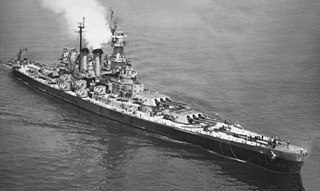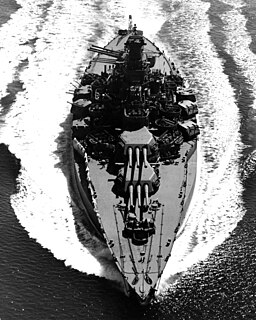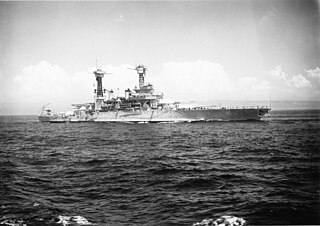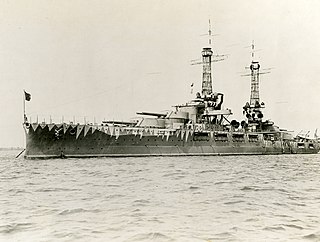 W
WThe Colorado-class battleships were a group of four United States Navy super-dreadnoughts, the last of its pre-Treaty battleships. Designed during World War I, their construction overlapped the end of that conflict and continued in its immediate aftermath. Though all four keels were laid, only three ships were launched: Colorado, Maryland, and West Virginia. Washington was over 75% completed when she was canceled under the terms of the Washington Naval Treaty in 1922. As such, the 16" gun Colorado-class ships were the last and most powerful battleships built by the U.S. Navy until the North Carolina class entered service on the eve of World War II.
 W
WThe Iowa class was a class of six fast battleships ordered by the United States Navy in 1939 and 1940. They were initially intended to intercept fast capital ships such as the Japanese Kongō class while also being capable of serving in a traditional battle line alongside slower battleships and act as its "fast wing". The Iowa class was designed to meet the Second London Naval Treaty's "escalator clause" limit of 45,000-long-ton (45,700 t) standard displacement. Four vessels, Iowa, New Jersey, Missouri, and Wisconsin, were completed; two more, Illinois and Kentucky, were laid down but canceled in 1945 and 1958, respectively, before completion, and both hulls were scrapped in 1958–1959.
 W
WThe Nevada class comprised two dreadnought battleships—Nevada and Oklahoma—built for the United States Navy in the 1910s. They were significant developments in battleship design, being the first in the world to adopt "all or nothing" armor, a major step forward in armor protection because it emphasized protection optimized for long-range engagements before the Battle of Jutland demonstrated the need for such a layout. They also introduced three-gun turrets and oil-fired water-tube boilers to the US fleet. The two Nevadas were the progenitors of the standard-type battleship, a group that included the next four classes of broadly similar battleships that were intended to be tactically homogeneous.
 W
WThe New Mexico-class was a class of three dreadnought battleships built for the United States Navy in the late 1910s. The class comprised three ships: New Mexico, the lead ship, Mississippi, and Idaho. Part of the standard series, they were in most respects copies of the Pennsylvania-class battleships that immediately preceded them, carrying the same main battery of twelve 14-inch (356 mm)/50 caliber guns. They incorporated several improvements, however, including a better arrangement of the secondary battery that increased its usability, a clipper bow that improved seakeeping, and New Mexico adopted an experimental turbo-electric propulsion system. Like the other standard-type battleships, they had a top speed of 21 knots that allowed the fleet to operate as a tactically homogeneous unit.
 W
WThe New York class was a pair of dreadnought battleships built for the United States Navy between 1911 and 1914. The two ships of the class, New York and Texas, saw extensive service beginning in the occupation of Veracruz, World War I, and World War II.
 W
WThe North Carolina class was a group of two fast battleships, North Carolina and Washington, built for the United States Navy in the late 1930s and early 1940s.
 W
WThe Pennsylvania-class consisted of two super-dreadnought battleships built for the United States Navy just before the First World War. The ships were named Pennsylvania and Arizona, after the American states of the same names. They constituted the United States' second battleship design to adhere to the "all or nothing" armor scheme, and were the newest American capital ships when the United States entered the First World War.
 W
WThe South Dakota class was a group of four fast battleships built by the United States Navy. They were the second class of battleships to be named after the 40th state; the first were designed in the 1920s and canceled under the terms of the Washington Naval Treaty. Four ships comprised the class: South Dakota, Indiana, Massachusetts, and Alabama. They were designed to the same treaty standard displacement limit of 35,000 long tons (35,600 t) as the preceding North Carolina class and had the same main battery of nine 16"/45 caliber Mark 6 guns in three-gun turrets, but were more compact and better protected. The ships can be visually distinguished from the earlier vessels by their single funnel, compared to twin funnels in the North Carolinas. According to naval historians William Garzke and Robert Dulin, the South Dakota design was the best "treaty battleship" ever built.
 W
WThe Tennessee class consisted of two super-dreadnought battleships—Tennessee and California—built for the United States Navy in the late 1910s, part of the "standard" series. The class was in most respects a repeat of the preceding New Mexico class, with the primary improvements being a significantly strengthened underwater protection system, and increased elevation of the main battery guns to allow them to fire at much greater ranges. They carried the same main battery of twelve 14-inch (356 mm) guns in four triple turrets, and had the same top speed of 21 knots. Both ships served in the Pacific Fleet for the duration of their careers, which included an extensive training program during the interwar period of the 1920s and 1930s.
 W
WThe Wyoming class was a pair of dreadnought battleships built for the United States Navy. Wyoming and Arkansas were authorized in early 1909, and were built between 1910 and 1912. These were the fourth dreadnought design of the US Navy, but only an incremental improvement over the preceding Florida class, and the last US battleships to use 12" guns. The primary changes were the addition of a sixth twin-gun turret, and improved armor protection, including the first use of a torpedo bulkhead on American battleships. The Navy considered using more powerful 14-inch (356 mm) guns, but this would have caused delays and required larger ships.
 W
WUSS Alabama (BB-60) is a retired battleship. She was the fourth and final member of the South Dakota class of fast battleships built for the United States Navy in the 1930s. The first American battleships designed after the Washington treaty system began to break down in the mid-1930s, they took advantage of an escalator clause that allowed increasing the main battery to 16-inch (406 mm) guns, but Congressional refusal to authorize larger battleships kept their displacement close to the Washington limit of 35,000 long tons (36,000 t). A requirement to be armored against the same caliber of guns as they carried, combined with the displacement restriction, resulted in cramped ships. Overcrowding was exacerbated by wartime modifications that considerably strengthened their anti-aircraft batteries and significantly increased their crews.
 W
WUSS Arizona (BB-39) was the second and last of the Pennsylvania-class of "super-dreadnought" battleships built for the United States Navy in the mid-1910s. Named in honor of the 48th state's recent admission into the union and commissioned in 1916, the ship remained stateside during World War I. Shortly after the end of the war, Arizona was one of a number of American ships that briefly escorted President Woodrow Wilson to the Paris Peace Conference. The ship was sent to Turkey in 1919 at the beginning of the Greco-Turkish War to represent American interests for several months. Several years later, she was transferred to the Pacific Fleet and remained there for the rest of her career.
 W
WUSS Arkansas (BB-33) was a dreadnought battleship, the second member of the Wyoming class, built by the United States Navy. She was the third ship of the US Navy named in honor of the 25th state, and was built by the New York Shipbuilding Corporation. She was laid down in January 1910, launched in January 1911, and commissioned into the Navy in September 1912. Arkansas was armed with a main battery of twelve 12-inch (305 mm) guns and capable of a top speed of 20.5 knots.
 W
WBattleship Row was the grouping of eight U.S. battleships in port at Pearl Harbor, Hawaii, when the Japanese attacked on 7 December 1941. These ships bore the brunt of the Japanese assault. They were moored next to Ford Island when the attack commenced. The ships were Arizona, California, Maryland, Nevada, Oklahoma, Pennsylvania, Tennessee, and West Virginia. A repair ship, Vestal, was also present, moored next to Arizona.
 W
WUSS California (BB-44) was the second of two Tennessee-class battleships built for the United States Navy between her keel laying in October 1916 and her commissioning in August 1921. The Tennessee class was part of the standard series of twelve battleships built in the 1910s and 1920s, and were developments of the preceding New Mexico class. They were armed with a battery of twelve 14-inch (356 mm) guns in four three-gun turrets. California served as the flagship of the Battle Fleet in the Pacific Ocean for duration of her peacetime career. She spent the 1920s and 1930s participating in routine fleet training exercises, including the annual Fleet Problems, and cruises around the Americas and further abroad, such as a goodwill visit to Australia and New Zealand in 1925.
 W
WUSS Colorado (BB-45) was a battleship of the United States Navy that was in service from 1923 to 1947. She was the lead ship of the Colorado class of battleships. Her keel was laid down on 29 May 1919, by the New York Shipbuilding Corporation. She was launched on 22 March 1921, and commissioned on 30 August 1923. She was armed with eight 16-inch (406 mm) guns and fourteen 5-inch (127 mm) deck guns; two 5-inch guns were removed in an overhaul.
 W
WUSS Idaho (BB-42), a New Mexico-class battleship, was the fourth ship of the United States Navy to be named for the 43rd state. She was the third of three ships of her class. Built by the New York Shipbuilding Corporation of Camden, New Jersey, she was launched in June 1917 and commissioned in March 1919. She was armed with a battery of twelve 14-inch (356 mm) guns in four three-gun turrets, and was protected by heavy armor plate, with her main belt armor being 13.5 inches (343 mm) thick.
 W
WUSS Indiana (BB-58) was the second of four South Dakota-class fast battleships built for the United States Navy in the 1930s. The first American battleships designed after the Washington treaty system began to break down in the mid-1930s, they took advantage of an escalator clause that allowed increasing the main battery to 16-inch (406 mm) guns, but refusal to authorize larger battleships kept their displacement close to the Washington limit of 35,000 long tons (36,000 t). A requirement to be armored against the same caliber of guns as they carried, combined with the displacement restriction, resulted in cramped ships, a problem that was exacerbated as wartime modifications that considerably strengthened their anti-aircraft batteries significantly increased their crews.
 W
WUSS Iowa (BB-61) is a retired battleship, the lead ship of her class, and the fourth in the United States Navy to be named after the state of Iowa. Owing to the cancellation of the Montana-class battleships, Iowa is the last lead ship of any class of United States battleships and was the only ship of her class to serve in the Atlantic Ocean during World War II.
 W
WUSS Maryland (BB-46), also known as "Old Mary" or "Fighting Mary" to her crewmates, was a Colorado-class battleship. She was the third ship of the United States Navy to be named in honor of the seventh state. She was commissioned in 1921, and serving as the flagship of the fleet, cruised to Australia, New Zealand, and Brazil.
 W
WUSS Massachusetts (BB-59) is the third of four South Dakota-class fast battleships built for the United States Navy in the late 1930s. The first American battleships designed after the Washington treaty system began to break down in the mid-1930s, they took advantage of an escalator clause that allowed increasing the main battery to 16-inch (406 mm) guns, but refusal to authorize larger battleships kept their displacement close to the Washington limit of 35,000 long tons (36,000 t). A requirement to be armored against the same caliber of guns as they carried, combined with the displacement restriction, resulted in cramped ships, a problem that was exacerbated by wartime modifications that considerably strengthened their anti-aircraft batteries and significantly increased their crews.
 W
WUSS Mississippi (BB-41/AG-128), the second of three members of the New Mexico class of battleship, was the third ship of the United States Navy named in honor of the 20th state. The ship was built at the Newport News Shipbuilding Company of Newport News, Virginia, from her keel laying in April 1915, her launching in January 1917, and her commissioning in December that year. She was armed with a battery of twelve 14-inch (356 mm) guns in four three-gun turrets, and was protected by heavy armor plate, with her main belt armor being 13.5 inches (343 mm) thick.
 W
WUSS Missouri (BB-63) is an Iowa-class battleship and was the third ship of the United States Navy to be named after the U.S. state of Missouri. Missouri was the last battleship commissioned by the United States and is best remembered as the site of the surrender of the Empire of Japan, which ended World War II.
 W
WUSS Nevada (BB-36), the second United States Navy ship to be named after the 36th state, was the lead ship of the two Nevada-class battleships. Launched in 1914, Nevada was a leap forward in dreadnought technology; four of her new features would be included on almost every subsequent US battleship: triple gun turrets, oil in place of coal for fuel, geared steam turbines for greater range, and the "all or nothing" armor principle. These features made Nevada, alongside its sister ship Oklahoma, the first US Navy "standard-type" battleships.
 W
WUSS New Jersey (BB-62) is an Iowa-class battleship, and was the second ship of the United States Navy to be named after the US state of New Jersey. New Jersey earned more battle stars for combat actions than the other three completed Iowa-class battleships, and was the only US battleship providing gunfire support during the Vietnam War.
 W
WUSS New Mexico (BB-40) was a battleship in service with the United States Navy from 1918 to 1946. She was the lead ship of a class of three battleships, and the first ship to be named for the state of New Mexico. Her keel was laid down on 14 October 1915 at the New York Navy Yard, she was launched on 23 April 1917, and was commissioned on 20 May 1918. She was the first ship with a turbo-electric transmission, which helped her reach a cruising speed of 10 knots. Shortly after completing initial training, New Mexico escorted the ship that carried President Woodrow Wilson to Brest, France to sign the Treaty of Versailles. The interwar period was marked with repeated exercises with the Pacific and Atlantic Fleets, use as a trial ship for PID controllers, and a major modernization between March 1931 and January 1933.
 W
WUSS New York (BB-34) was a United States Navy battleship, the lead ship of her class. Named for New York State, she was designed as the first ship to carry the 14-inch (356 mm)/45-caliber gun.
 W
WUSS North Carolina (BB-55) is the lead ship of the North Carolina class of fast battleships, the first vessel of the type built for the United States Navy. Built under the Washington Treaty system, North Carolina's design was limited in displacement and armament, though the United States used a clause in the Second London Naval Treaty to increase the main battery from the original armament of twelve 14-inch (356 mm) guns to nine 16 in (406 mm) guns. The ship was laid down in 1937 and completed in April 1941, while the United States was still neutral during World War II.
 W
WUSS Oklahoma (BB-37) was a Nevada-class battleship built by the New York Shipbuilding Corporation for the United States Navy, notable for being the first American class of oil-burning dreadnoughts.
 W
WUSS Pennsylvania (BB-38) was the lead ship of the Pennsylvania class of super-dreadnought battleships built for the United States Navy in the 1910s. The Pennsylvanias were part of the standard-type battleship series, and marked an incremental improvement over the preceding Nevada class, carrying an extra pair of 14-inch (356 mm) guns for a total of twelve guns. Named for the Commonwealth of Pennsylvania, she was laid down at the Newport News Shipbuilding and Drydock Company in October 1913, was launched in March 1915, and was commissioned in June 1916. Equipped with an oil-burning propulsion system, Pennsylvania was not sent to European waters during World War I, since the necessary fuel oil was not as readily available as coal. Instead, she remained in American waters and took part in training exercises; in 1918, she escorted President Woodrow Wilson to France to take part in peace negotiations.
 W
WUSS South Dakota (BB-57) was the lead vessel of the four South Dakota-class fast battleships built for the United States Navy in the 1930s. The first American battleships designed after the Washington treaty system began to break down in the mid-1930s, the South Dakotas were able to take advantage of a treaty clause that allowed them to increase the main battery to 16-inch (406 mm) guns. However, congressional refusal to authorize larger battleships kept their displacement close to the Washington limit of 35,000 long tons (36,000 t). A requirement to be armored against the same caliber of guns as they carried, combined with the displacement restriction, resulted in cramped ships. Overcrowding was exacerbated by wartime modifications that considerably strengthened their anti-aircraft batteries and significantly increased their crews.
 W
WUSS Tennessee (BB-43) was the lead ship of the Tennessee class of dreadnought battleships built for the United States Navy in the 1910s. The Tennessee class was part of the standard series of twelve battleships built in the 1910s and 1920s, and were developments of the preceding New Mexico class. They were armed with a battery of twelve 14-inch (356 mm) guns in four three-gun turrets. Tennessee served in the Pacific Fleet for duration of her peacetime career. She spent the 1920s and 1930s participating in routine fleet training exercises, including the annual Fleet Problems, and cruises around the Americas and further abroad, such as a goodwill visit to Australia and New Zealand in 1925.
 W
WUSS Texas (BB-35) is a museum ship and former United States Navy New York-class battleship. She was launched on 18 May 1912 and commissioned on 12 March 1914.
 W
WUSS Washington (BB-56) was the second and final member of the North Carolina class of fast battleships, the first vessel of the type built for the United States Navy. Built under the Washington Treaty system, North Carolina's design was limited in displacement and armament, though the United States used a clause in the Second London Naval Treaty to increase the main battery from the original armament of nine 14 in (356 mm) guns to nine 16 in (406 mm) guns. The ship was laid down in 1938 and completed in May 1941, while the United States was still neutral during World War II. Her initial career was spent training along the East Coast of the United States until after Japan attacked Pearl Harbor on 7 December 1941, bringing the United States into the war.
 W
WUSS West Virginia (BB-48) was the fourth dreadnought battleship of the Colorado class, though because Washington was cancelled, she was the third and final member of the class to be completed. The Colorado class proved to be the culmination of the standard-type battleship series built for the United States Navy in the 1910s and 1920s; the ships were essentially repeats of the earlier Tennessee design, but with a significantly more powerful main battery of eight 16-inch (406 mm) guns in twin-gun turrets. West Virginia was built between her keel laying in 1920 and her commissioning into the Navy in 1923. The ship spent the 1920s and 1930s conducting routine training exercises, including the typically-annual Fleet Problems, which provided invaluable experience for the coming war in the Pacific.
 W
WUSS Wisconsin (BB-64) is an Iowa-class battleship, the second ship of the United States Navy to be named in honor of the U.S. state of Wisconsin. She was built at the Philadelphia Naval Shipyard in Philadelphia, Pennsylvania and launched on 7 December 1943, sponsored by the wife of Governor Walter Goodland of Wisconsin.
 W
WUSS Wyoming (BB-32) was the lead ship of her class of dreadnought battleships and was the third ship of the United States Navy named Wyoming, although she was only the second named in honor of the 44th state. Wyoming was laid down at the William Cramp & Sons in Philadelphia in February 1910, was launched in May 1911, and was completed in September 1912. She was armed with a main battery of twelve 12-inch (305 mm) guns and capable of a top speed of 20.5 kn.